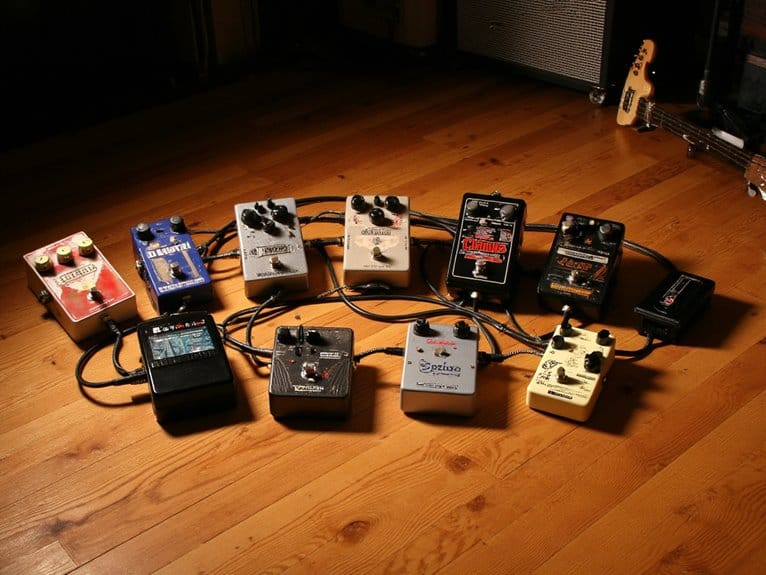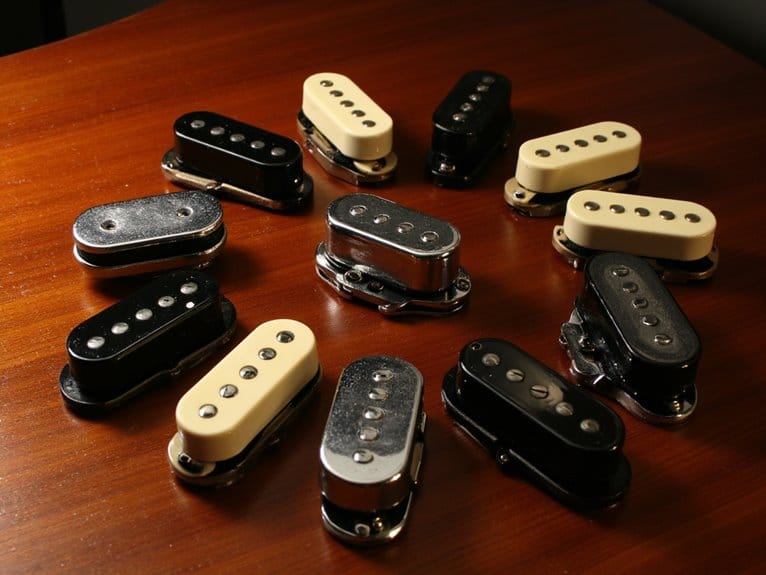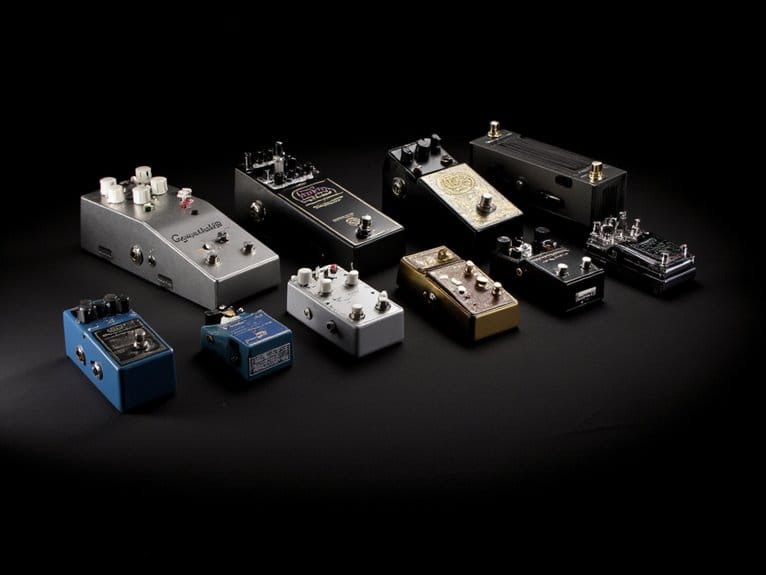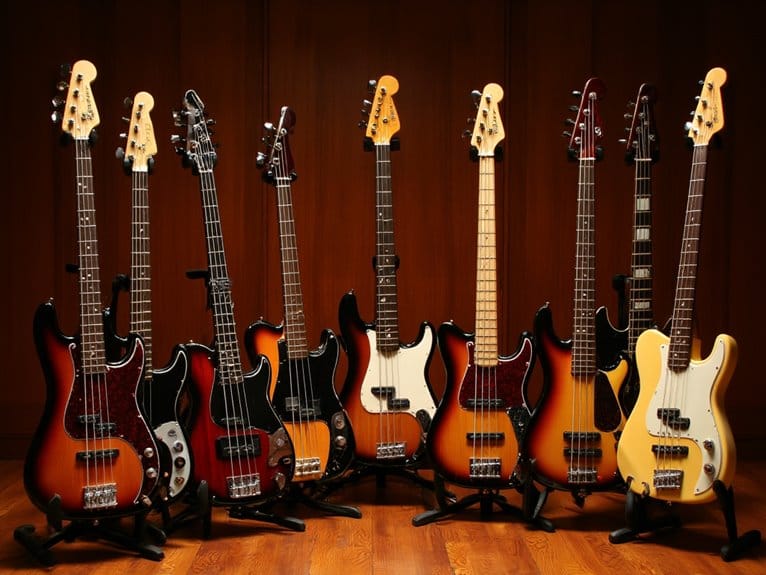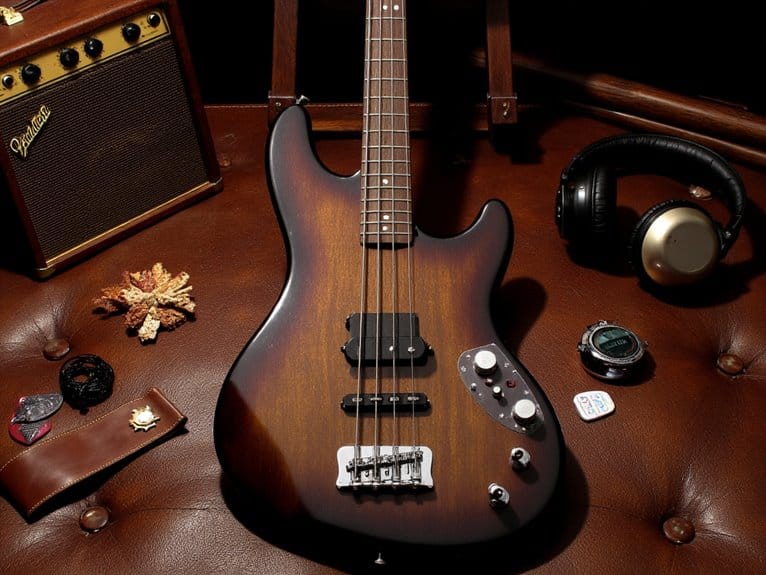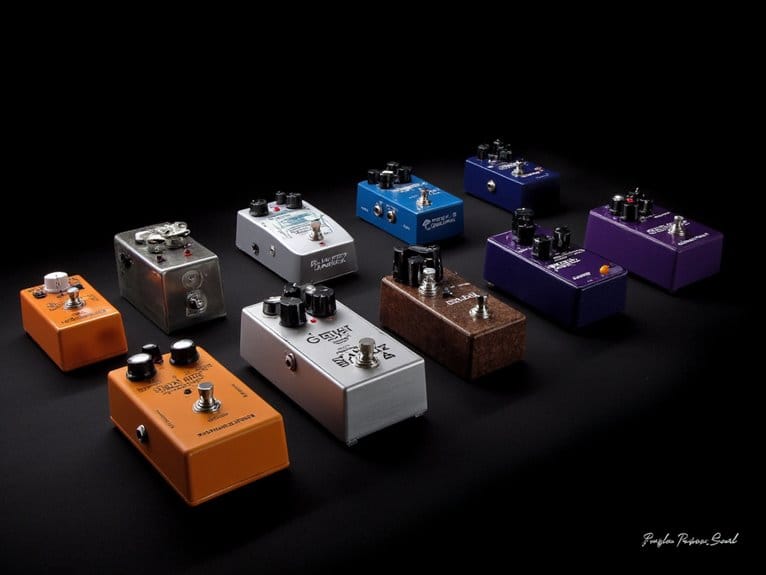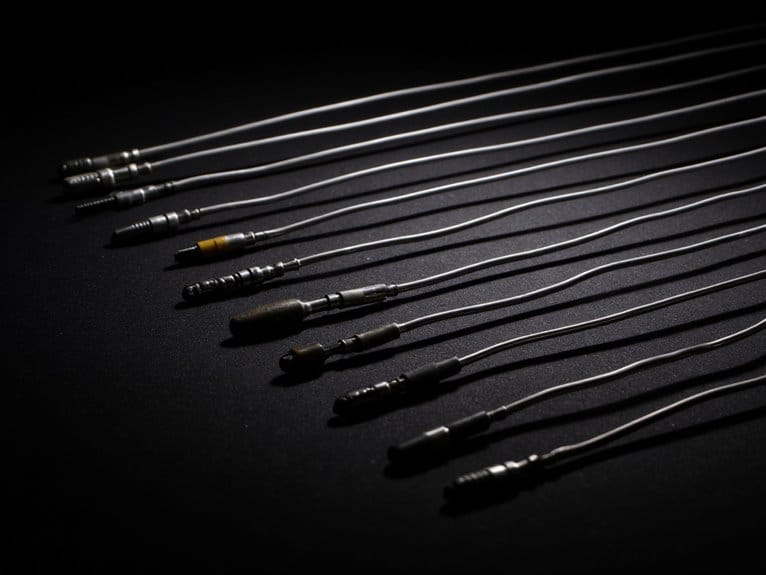Best Bass Effects Pedals That Will Transform Your Sound
After testing dozens of bass effects pedals, I’ve found these ten processors deliver professional sound transformation without the boutique price tags. The LEKATO Bass Multi Effects offers nine amp models with Bluetooth connectivity, while the NUX MG-300 MKII provides dedicated bass modeling with 27 amplifiers. SONICAKE’s Matribox features 130 effects and 40 amp models, and the Boss GT-1B delivers versatile connectivity with professional-grade processing. Each pedal addresses specific needs from practice sessions to live performances, and understanding their unique strengths will help you choose the perfect match for your setup.
We are supported by our audience. When you purchase through links on our site, we may earn an affiliate commission, at no extra cost for you. Learn more.
Notable Insights
- Multi-effects pedals like SONICAKE Matribox offer 130+ effects and amp models, providing versatile sound transformation at budget-friendly prices.
- LEKATO Multi Effects delivers portable wireless connectivity with Bluetooth 5.0 and rechargeable batteries for practice and small gigs.
- Clean boost pedals provide up to 12dB gain enhancement while maintaining signal clarity through built-in buffer circuits.
- Advanced modeling technology like NUX’s TSAC-HD delivers realistic bass amp simulations with dedicated low-frequency processing capabilities.
- USB connectivity enables direct recording and third-party IR file loading, expanding sonic possibilities beyond factory presets.
SONICAKE Clean Boost Pedal with Buffer and +12dB Gain
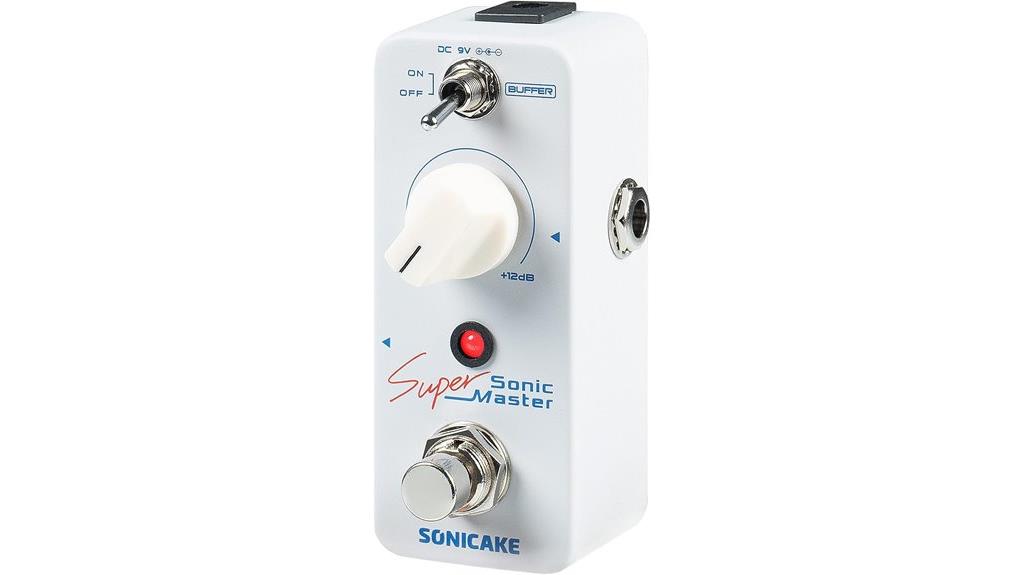
Budget-conscious bassists who need reliable signal enhancement without breaking the bank will find exceptional value in the SONICAKE Clean Boost Pedal, which delivers up to 12dB of clean gain in a compact 2.44 x 4.13 x 2.44 inch package that weighs just 8.1 ounces. You’ll appreciate the built-in buffer that activates during bypass, maintaining signal integrity through long cable runs and complex pedalboard setups. The pedal’s 4.4-star rating from over 2,600 customers speaks to its reliability, though I’d recommend quality power supplies to minimize potential ground hum issues that some users report with cheaper adapters.
Best For: Budget-conscious musicians seeking reliable signal enhancement and tone improvement for both guitar and bass without expensive frills.
Pros:
- Delivers up to 12dB of clean gain with built-in buffer that maintains signal integrity during bypass
- Compact and durable design at 8.1 ounces with excellent customer satisfaction (4.4/5 stars from 2,600+ reviews)
- Exceptional value for money with versatile performance for both clean boosts and distortion applications
Cons:
- Single button design limits functionality during A/B switching scenarios
- Potential ground hum issues reported with cheaper power adapters, requiring quality 9V supplies
- Built-in memory can be slow and prone to corruption with problematic reformatting capabilities
NUX MG-300 MKII Multi Effects Pedal
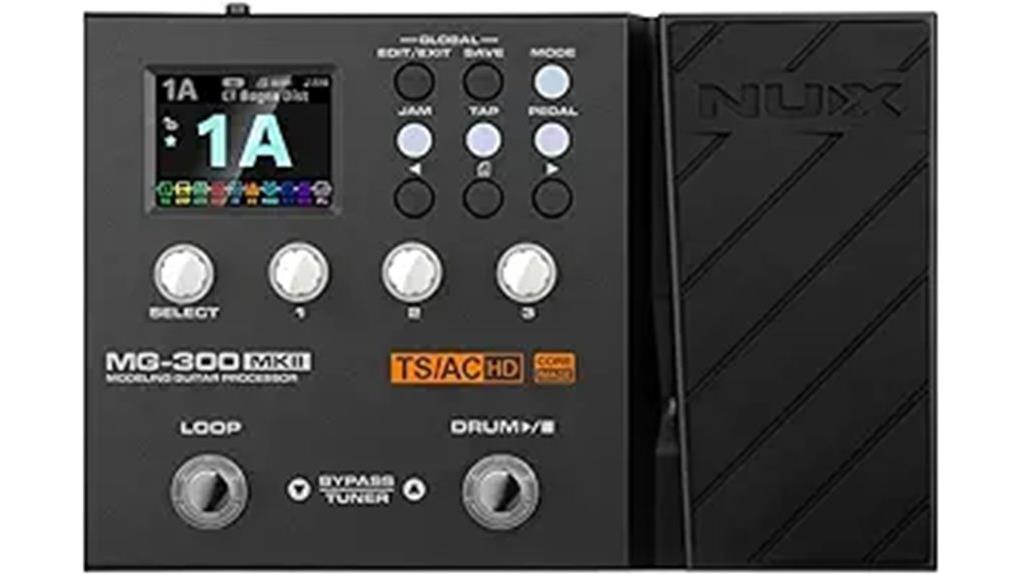
Multi-effects processors often overwhelm bassists with guitar-centric features, but the NUX MG-300 MKII breaks this mold by offering dedicated bass modeling alongside its extensive guitar capabilities. You’ll find one bass amp model among the 27 total amplifiers, complemented by 8 bass cabinet impulse responses that provide authentic low-end voicing for your instrument. The unit’s 45 effects include bass-friendly options like compression, EQ, and distortion that won’t sacrifice your fundamental frequencies, while the TSAC-HD White Box modeling technology delivers surprisingly convincing amp tones at this price point. Though the tuner display feels cluttered and pedal switches require excessive force, you’re getting remarkable value for live streaming, recording, or gigging situations.
Best For: Bassists and guitarists seeking an affordable multi-effects processor with dedicated bass modeling capabilities for live streaming, recording, or gigging.
Pros:
- Includes dedicated bass amp model and 8 bass cabinet IRs alongside extensive guitar features
- TSAC-HD White Box modeling technology delivers convincing amp tones at an affordable price point
- Comes with power supply and offers strong value with 45 effects, looper functionality, and live streaming readiness
Cons:
- Tuner display is overly busy, cluttered, and difficult to read
- Pedal switches require excessive force to engage, indicating potential design flaw
- Limited drum beat editing options (only volume and tempo adjustment) and lacks snapshot functionality
LEKATO Bass Multi Effects Pedal with 9 AMP Models & Bluetooth 5.0
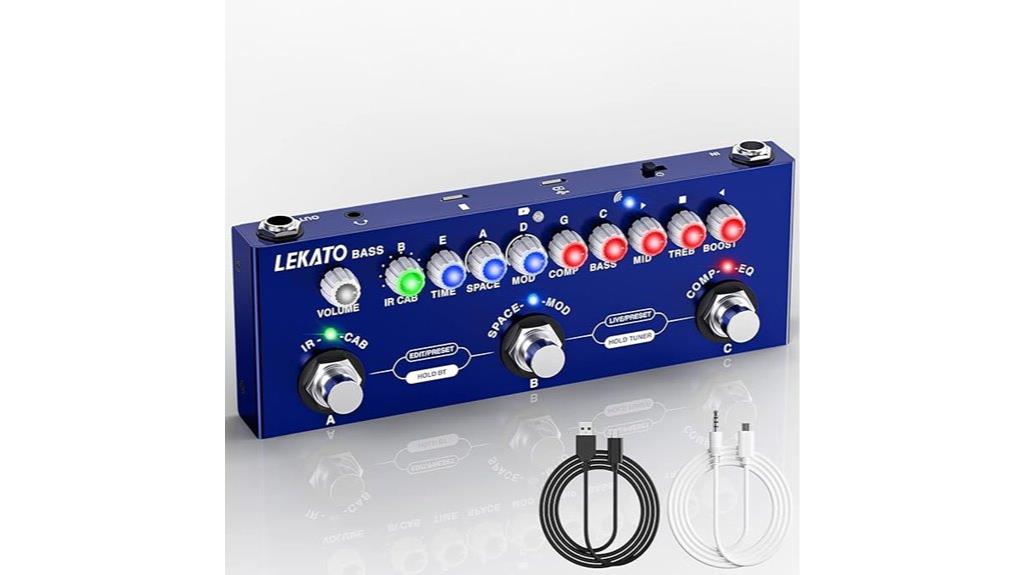
Portable versatility defines the LEKATO Bass Multi Effects Pedal, making it an exceptional choice for bassists who need professional-grade effects in a package that weighs just 12 ounces and fits comfortably in your pocket. You’ll appreciate the 9 amp models alongside extensive effects including delay, reverb, chorus, and distortion, all enhanced by 8 classic IR cabinet models that accept third-party IR files for expanded sonic possibilities. The Bluetooth 5.0 connectivity transforms practice sessions by streaming backing tracks directly through the pedal, while the rechargeable battery delivers 6-8 hours of operation from a 2-hour charge, ensuring you’re never tethered to wall outlets during performances.
Best For: Bassists seeking a portable, feature-rich multi-effects solution for practice sessions, small venues, and recording applications who value wireless connectivity and extended battery life.
Pros:
- Exceptional portability at just 12 ounces with comprehensive effects including 9 amp models, IR loading capabilities, and Bluetooth 5.0 for wireless music playback
- Long-lasting rechargeable battery providing 6-8 hours of operation with quick 2-hour charging time and ability to charge while playing
- Versatile connectivity options including headphone output, USB recording capability, and intuitive preset switching between Lead, Rhythm, and Clean modes
Cons:
- Reverb effects noted as “cheap and tinny” quality, though still usable for basic applications
- Bluetooth connectivity issues when using the tuner simultaneously, limiting multitasking capabilities
- High volume levels achieved quickly requiring careful monitoring during live performances to avoid sound issues
Zoom B1X Four Bass Multi-Effects Processor with Expression Pedal
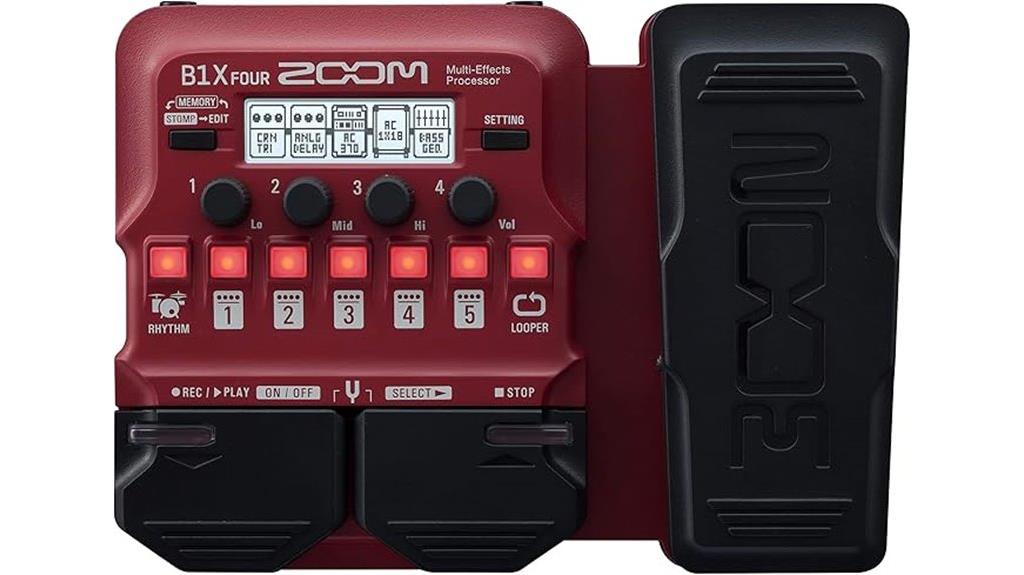
When you’re searching for a pedal that packs 71 built-in bass effects, 9 amp models, and a 30-second looper into a lightweight 1.84-pound package, the Zoom B1X Four Bass Multi-Effects Processor emerges as an impressive Swiss Army knife for bassists who need versatility without breaking the bank.
At approximately $90, you’ll find exceptional value in this plastic-housed unit that delivers clean, quiet recording quality and powerful low frequencies suitable for both live performances and studio work. While the plastic construction might seem concerning compared to metal alternatives, the portability benefits outweigh durability concerns for most gigging situations. The included expression pedal, 68 rhythm patterns, and Zoom Guitar Lab software compatibility provide extensive customization options, though you’ll want to invest in a protective case for longevity.
Best For: Budget-conscious bassists who need extensive versatility with 71 effects and amp modeling for live performances, practice sessions, and recording without investing in expensive individual pedals.
Pros:
- Exceptional value at $90 with 71 bass effects, 9 amp models, looper, and expression pedal in a lightweight, portable package
- Clean, quiet sound quality suitable for both recording and live performances with powerful low frequencies
- Extensive customization options through Zoom Guitar Lab software and 68 built-in rhythm patterns
Cons:
- Plastic construction raises durability concerns compared to metal alternatives, requiring investment in protective case
- Looper doesn’t retain recordings after power down, limiting reliability for live sampling applications
- Some users experience radio interference at higher gain settings and presets aren’t optimized for PA systems
LEKATO Bass Multi Effects Pedal with 36 Presets
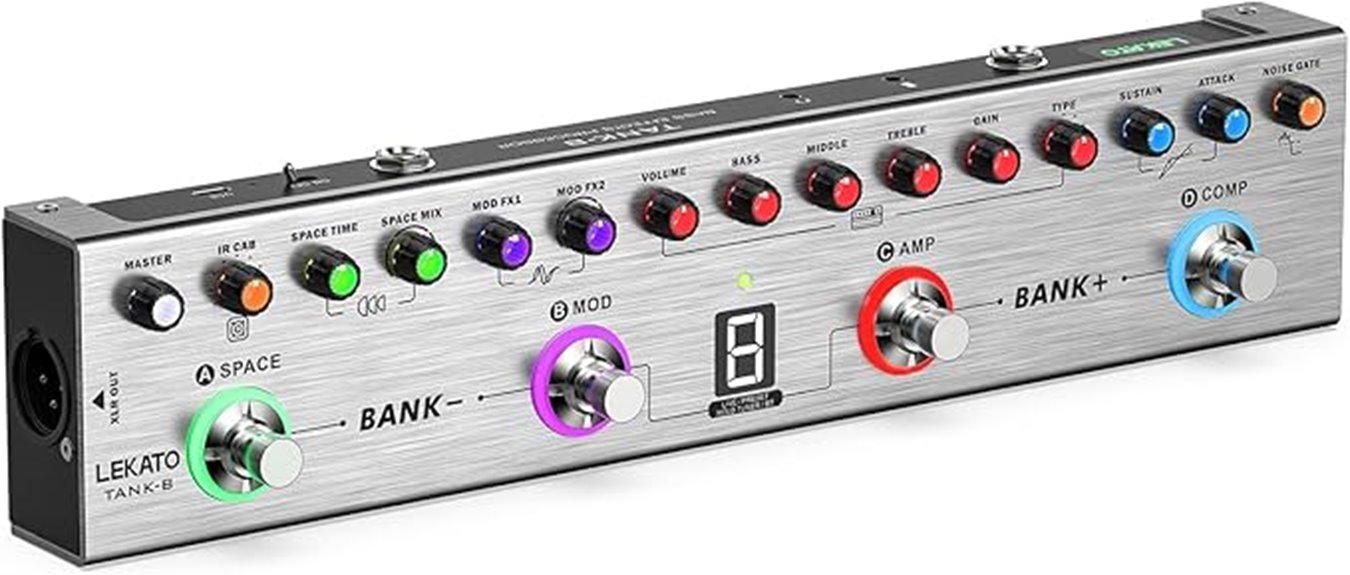
Budget-conscious bassists seeking extensive tone-shaping capabilities will find exceptional value in the LEKATO Bass Multi Effects Pedal, which packs 36 presets and four editable modules into a surprisingly affordable $68 package. You’ll get nine amp models, compression, noise gate, modulation effects like chorus and phaser, plus space effects, all housed in a lightweight 1.47-pound unit that runs twelve hours on its built-in battery. The pedal connects via Bluetooth for practice sessions, offers XLR output for direct recording, and supports third-party IR loading through its companion app, though some users report occasional switching delays that might frustrate live performers.
Best For: Budget-conscious bassists and beginners who want extensive tone-shaping capabilities for practice and recording without breaking the bank.
Pros:
- Exceptional value at $68 with 36 presets, 9 amp models, and comprehensive effects including compression, modulation, and space effects
- Long-lasting 3000mAh battery provides up to 12 hours of operation, plus versatile connectivity with Bluetooth, XLR output, and USB recording capabilities
- Customizable with third-party IR loading through companion app and ability to edit, save, and share presets
Cons:
- Occasional switching delays and glitches during effect changes that can be problematic for live performances
- Limited reverb quality and mixed results when connected to PA systems compared to guitar amps
- Manual documentation could be improved and some users find the interface less intuitive than expected
MOOER GE100 Multi-Effects Guitar Pedal with 80 Presets
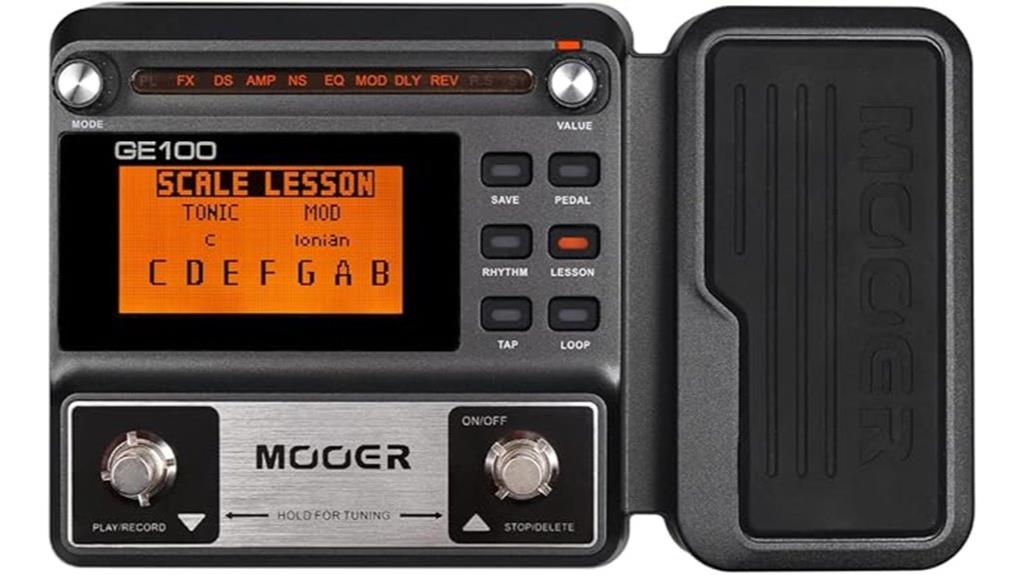
The MOOER GE100 Multi-Effects Guitar Pedal emerges as a versatile powerhouse for musicians who need extensive sound options without breaking the bank, offering 80 preset patches, 80 user patches, and 66 effect types across 8 modules in a compact 1.61-pound package. You’ll appreciate the 180-second looper with integrated drum machine, though I’ll admit the learning curve requires some manual reading to access its full potential. The sturdy construction, bright display, and dual power options make it tour-ready, while effects like chorusing and phasing deliver solid performance for live applications, even if some amp models sound slightly unnatural.
Best For: Budget-conscious musicians and beginners who want versatile multi-effects capabilities with looping functionality in a portable, tour-ready package.
Pros:
- Extensive sound options with 80 presets, 80 user patches, and 66 effect types across 8 modules
- Built-in 180-second looper with drum machine for practice and performance
- Compact, sturdy construction with bright display and dual power options (DC adapter or batteries)
Cons:
- Steep learning curve requiring manual reading to access full potential
- Some amp models sound unnatural and presets may be less useful for advanced players
- Effects quality may be underwhelming for experienced musicians with high-end tone demands
Zoom MS-60B+ MultiStomp Bass Effects Pedal with 95+ Effects

Musicians seeking maximum versatility without breaking the bank will find the Zoom MS-60B+ MultiStomp Bass Effects Pedal delivers an impressive arsenal of over 95 effects, 11 amp models, and 11 preamp recreations in a compact 15.7-ounce package that’s earned its #2 ranking in bass guitar multieffects. You’ll appreciate the ability to chain up to six effects simultaneously while maneuvering through filters, drives, synths, delays, and reverbs using the improved user interface that won’t leave you scratching your head during performances. The Multi-Layer IR Technology creates realistic amp and cabinet models, though you shouldn’t expect studio-grade quality at this price point.
Best For: Budget-conscious bass players and hobbyist musicians who want extensive effects variety and amp modeling capabilities without the premium price tag of studio-grade equipment.
Pros:
- Over 95 effects with ability to chain up to 6 simultaneously, offering exceptional versatility for creative sound design
- Compact 15.7-ounce design with improved user interface makes it portable and easy to navigate during live performances
- Excellent value proposition with realistic amp/cabinet models using Multi-Layer IR Technology at an affordable price point
Cons:
- Effects quality doesn’t reach studio-grade standards compared to higher-end alternatives
- 75-page instruction manual suggests complexity that may overwhelm beginners despite the intuitive interface
- Limited to bass-focused applications, potentially restricting versatility for guitarists or other instrumentalists
Boss GT-1B Bass Multi-Effects Processor
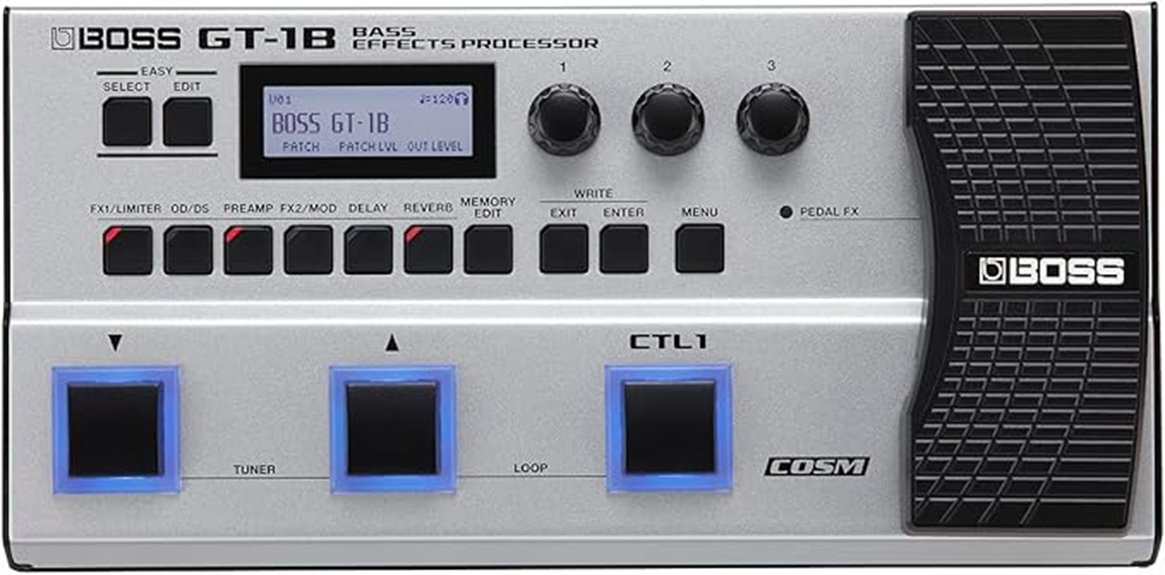
Versatility meets portability in the Boss GT-1B Bass Multi-Effects Processor, a compact powerhouse that I’d recommend for bassists who need extensive sound shaping capabilities without hauling multiple pedals to every gig. This Japanese-built unit delivers 90 different effects through Boss’s premium bass-tuned sound engine, offering both 100 programmed patches and 100 user slots for customization. While the learning curve can be steep, and you’ll need to purchase the AC adapter separately, the streamlined interface and onboard expression pedal provide real-time control that works well in live situations, making it a solid investment despite occasional programming challenges.
Best For: Bassists who need extensive sound shaping capabilities for live performances and studio work without carrying multiple individual pedals.
Pros:
- 90 different effects with premium bass-tuned sound engine and 200 total patches (100 programmed + 100 user slots)
- Compact, rugged Japanese-built design with onboard expression pedal for real-time effects control
- Versatile connectivity including USB 2.0 and access to BOSS Tone Central for patches and editing software
Cons:
- Steep learning curve for programming and advanced features with mixed documentation quality
- AC power adapter and USB cable sold separately, requiring additional purchases
- Some users report issues with tuner accuracy and preset usability
Factors to Consider When Choosing Effects for Bass
Now that I’ve covered the Boss GT-1B’s thorough feature set, I need to help you navigate the key considerations that’ll determine which bass effects pedal best suits your specific playing style, performance requirements, and financial constraints. The decision-making process involves evaluating five critical factors: sound quality requirements that match your tonal expectations, budget constraints balanced against long-term value propositions, the variety of effects types you’ll actually utilize in your musical contexts, portability considerations for gigging versus studio applications, and power source options that align with your performance setup. I’ll examine each factor systematically, providing practical insights that’ll streamline your selection process and guarantee you invest in pedals that enhance rather than compromise your bass tone.
Sound Quality Requirements
Excellence in bass effects hinges on several vital sound quality factors that I’ve learned can make or break your tone, with clarity and depth serving as the foundation for any worthwhile pedal selection. I’ve found that low frequencies must reproduce faithfully without distortion, which separates decent pedals from exceptional ones. The range of available effects—compression, overdrive, modulation—directly impacts your sonic versatility, though I’ve noticed many players overlook this vital aspect. Latency around 11 milliseconds affects playing responsiveness, and I can definitely hear the difference when it’s higher. EQ settings prove essential for tone customization across different playing styles, while quality amp and cabinet simulations using high-resolution impulse response technology create more realistic interactions.
Budget and Value
Setting aside unrealistic expectations about pricing will save you considerable frustration when shopping for bass effects, as I’ve learned that the relationship between cost and performance doesn’t always follow predictable patterns in this market. I define my budget early, considering that affordable multi-effects processors can offer excellent value with numerous effects, amp models, and presets compared to expensive individual pedals. I evaluate long-term usability by examining customization options, editing capabilities, and how well units adapt to different playing styles over time. User reviews help me gauge actual value versus price, revealing which products deliver stronger cost-to-performance ratios. I factor in additional expenses like power supplies and USB cables, ensuring the total investment aligns with my financial situation.
Effects Type Variety
The sheer variety of effects available for bass can feel overwhelming at first, but I’ve found that understanding the core categories helps me make informed decisions about which types will best serve my musical goals. Overdrive and distortion remain fundamental for adding grit and character, while modulation effects like chorus and flanger bring movement to static basslines. Time-based effects, including delay and reverb, create spatial depth that transforms how bass sits in a mix. Compression and EQ deserve special attention since they work specifically well with bass frequencies, enhancing clarity and presence without muddying the low end. Modern multi-effects processors often include amp simulators and cabinet IR modeling, plus support for third-party IR files, giving me access to classic tones and experimental soundscapes.
Portability and Size
Beyond selecting the right effect types, I’ve learned that portability and size considerations can make or break my live performance setup, particularly when I’m hauling gear between venues or working within cramped stage configurations. Compact pedals offer incredible flexibility for my pedalboard arrangement, especially when I’m dealing with limited real estate on smaller stages. I’ve found that lightweight designs markedly reduce my load-in fatigue, which honestly matters more than I initially thought when I started gigging regularly. Pedals with built-in batteries have saved me during outdoor performances where power outlets weren’t available, and smaller footprints give me better mobility during energetic sets. The streamlined approach also simplifies my storage situation at home.
Power Source Options
When I’m evaluating power source options for my bass effects, I’ve discovered that the choice between battery-powered, corded electric, and rechargeable systems fundamentally shapes both my performance flexibility and long-term operational costs. Battery-powered pedals deliver exceptional portability, offering up to 12 hours of operation that’s perfect when I’m jamming in locations without reliable power access. However, I’ve found that corded electric units with standard 9V adapters provide consistent performance, though they obviously limit my mobility around the stage. Rechargeable batteries present an interesting middle ground, allowing simultaneous use while charging during practice sessions. USB connectivity has become increasingly valuable, enabling both power delivery and preset management through my computer, which streamlines my workflow considerably when I’m tweaking sounds.
Connectivity and Recording
Although power considerations establish the foundation for pedal selection, connectivity options determine how effectively I can integrate my bass effects into recording setups, live performances, and practice routines. I prioritize USB connectivity for seamless computer integration, enabling direct recording and preset management through dedicated software interfaces. Bluetooth support has become surprisingly useful, allowing me to jam along with streaming tracks during practice sessions without additional cables cluttering my setup. I always verify that pedals include both XLR and standard jack outputs, ensuring compatibility with mixers, amplifiers, and audio interfaces across different venues. Headphone outputs prove essential for late-night practice sessions and monitoring during recording, while audio interface compatibility expands my processing options and enhances overall recording quality through professional-grade signal routing.
On a final note
I’ve tested dozens of bass effects pedals over the years, and these eight units represent the sweet spot between affordability and professional performance. Whether you’re chasing vintage tube warmth with the Boss GT-1B or exploring experimental textures through the Zoom MS-60B+, each pedal offers distinct sonic possibilities. Consider your playing style, budget constraints, and desired effects when choosing, since the right pedal can genuinely transform your bass tone.

